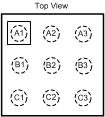SNVS891H September 2012 – September 2015 LM3642
PRODUCTION DATA.
- 1 Features
- 2 Applications
- 3 Description
- 4 Revision History
- 5 Pin Configuration and Functions
- 6 Specifications
- 7 Detailed Description
- 8 Application and Implementation
- 9 Power Supply Recommendations
- 10Layout
- 11Device and Documentation Support
- 12Mechanical, Packaging, and Orderable Information
Package Options
Mechanical Data (Package|Pins)
- YZR|9
Thermal pad, mechanical data (Package|Pins)
Orderable Information
5 Pin Configuration and Functions
YZR Package
9-Pin DSBGA
Top View

Pin Functions
| PIN | I/O | DESCRIPTION | |
|---|---|---|---|
| NO. | NAME | ||
| A1 | OUT | Power | Step-up DC-DC converter output. Connect a 10-µF ceramic capacitor between this pin and GND. |
| A2 | SW | Power | Drain connection for internal NMOS and synchronous PMOS switches. |
| A3 | GND | Ground | Ground |
| B1 | LED | Output | High-side current source output for Flash LED. |
| B2 | STROBE | Input | Active high hardware Flash enable. Drive STROBE high to turn on Flash pulse. Has an internal pulldown resistor of 300 kΩ between STROBE and GND. |
| B3 | IN | Power | Input voltage connection. Connect IN to the input supply, and bypass to GND with a 10-µF or larger ceramic capacitor. |
| C1 | TX/TORCH | Input | Configurable power amplifier synchronization input or configurable active high Torch enable. Has an internal pulldown resistor of 300 kΩ between TX and GND. |
| C2 | SDA | Input/Output | Serial data input/output. |
| C3 | SCL | Input | Serial clock input. |